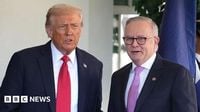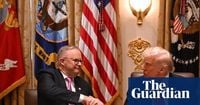On October 20, 2025, the diplomatic corridors of the White House buzzed with a sense of urgency and purpose as President Donald Trump welcomed Australian Prime Minister Anthony Albanese for a high-stakes meeting. The agenda? Securing the future of the AUKUS defense pact and forging a landmark minerals deal poised to reshape the global balance of power in technology and defense.
This visit marked a pivotal moment for the trilateral AUKUS alliance—comprised of the United States, United Kingdom, and Australia—at a time when questions swirled internationally about the U.S.'s long-term commitment. According to BBC, this was the first time President Trump publicly reaffirmed America’s dedication to the pact, allaying anxieties that had grown since the start of his second term. The AUKUS agreement, launched in 2021 under the Biden administration, supports Australia’s acquisition of conventionally armed, nuclear-powered submarines and enhances cooperation on advanced military technologies such as artificial intelligence. With mounting tensions in the Indo-Pacific, particularly given China’s ambitions regarding Taiwan, the stakes could hardly be higher.
"We’ve been working on that for quite a while. In about a year from now, we’ll have so much critical minerals and rare earths that you won’t know what to do with them. They’ll be worth about $2. But in the meantime, we’re working with Australia and other countries," Trump remarked during the bilateral meeting, as reported by The Associated Press. His comments underscored the urgency both nations feel about diversifying their sources of critical minerals—resources vital for everything from computer chips to advanced weaponry.
China’s grip on the global supply of these minerals has long been a source of unease in Washington and Canberra. Since the 1990s, Beijing has methodically established dominance over both the mining and processing of rare earth materials, making itself an indispensable player in the world’s technology and defense supply chains. More recently, China introduced new rules requiring foreign firms to obtain its approval before exporting magnets containing even trace amounts of China-originated rare earths or produced with Chinese technology. As AP noted, this move sent a chill through global markets, signaling Beijing’s willingness to leverage its mineral might as a geopolitical weapon.
Against this backdrop, Trump and Albanese unveiled a sweeping plan to invest jointly in critical minerals projects. The White House released a fact sheet stating that the two governments intend to invest more than $3 billion in such projects within the next six months. Albanese, for his part, described the initiative as "an $8.5 billion pipeline that we have ready to go." The deal, negotiated over several months, aims to catalyze the expansion of mining and, crucially, processing capacity for rare earths outside of China. That’s a tall order, as both the U.S. and Australia remain heavily reliant on China for turning raw minerals into usable materials for industry.
"This is an $8.5 billion pipeline that we have ready to go," Albanese stated, according to AP. The agreement is not just about digging minerals out of the ground. As BBC explained, both countries recognize that breaking their dependence on Chinese processing will require significant investment—often with government backing. The U.S. has already begun investing in firms such as MP Materials, Trilogy Metals, and Lithium Americas to shore up the domestic supply chain, sometimes taking ownership stakes in these companies. Now, the U.S. government plans to invest in Australian companies as well, as part of a broader $1 billion commitment over the next six months. The news sent the share prices of Australian firms like Lynas Rare Earths soaring ahead of the meeting.
But the long-term picture is less certain. Some analysts and industry insiders, as BBC highlighted, wonder how committed the Trump administration will be if future projects don’t deliver direct benefits to U.S. soil. This uncertainty could complicate ongoing talks and future collaboration. Still, the immediate momentum is undeniable.
Defense Secretary Pete Hegseth and Navy Secretary John Phelan were present at the White House roundtable, emphasizing the military dimension of the partnership. Phelan pointed to the construction of a new naval facility in southwest Australia that will allow for a rotating force of U.S. nuclear-powered submarines beginning in 2027—a date that ominously coincides with President Xi Jinping’s stated deadline for the People’s Liberation Army to be ready to "unify" Taiwan. "The naval facility Australia is building in the southwest that will enable a rotating force of nuclear-powered submarines is very important to our ability to project power in the Indo-Pacific and work with allies," Phelan said, signaling the growing strategic weight of the region.
For Trump, the AUKUS alliance is more than a diplomatic gesture—it’s a linchpin in the U.S. strategy to contain Chinese ambitions. "We are way ahead of China militarily. The United States, we’re way ahead of them in every form of military—other than they’re building a lot of ships—and we’ll have that started. We’ll be catching them on that," Trump asserted. "We’re way ahead of China on AI, and we’re way ahead of China militarily. From the standpoint of sophisticated weapons, we have weapons that a lot of people don’t even know about." While he described AUKUS as a deterrent to China, Trump also expressed confidence that outright conflict could be avoided.
Looking ahead, the diplomatic chess game continues. Trump confirmed plans to meet Chinese President Xi Jinping at the Asia-Pacific Economic Cooperation summit later in October in South Korea, with a reciprocal visit to China "fairly early next year." Both sides, however, are threatening tariffs exceeding 100% on each other’s goods unless a new trade agreement is reached before November 1. "If we make a deal, that’s great. If we don’t make a deal, a lot of people are going to be paying a big price," Trump warned, underscoring the high stakes for global markets and supply chains.
For now, the U.S.-Australia minerals deal stands as a bold step to counter China’s dominance, shore up critical supply chains, and reinforce the military and technological bonds underpinning the AUKUS alliance. Whether this momentum can be sustained—and whether it will truly shift the global balance—remains to be seen. But for both Washington and Canberra, the message is clear: the era of critical minerals as a strategic asset has arrived, and neither nation intends to be caught flat-footed.

